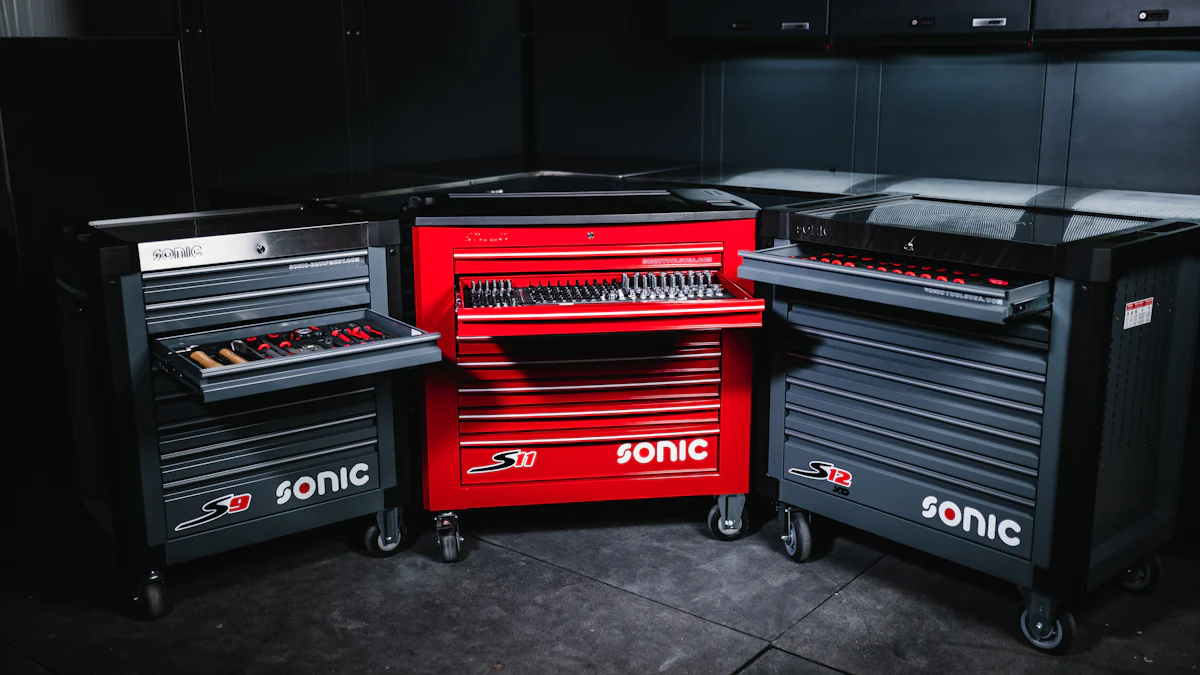 Choosing the right tool storage is crucial, with the global tool storage products market expected to reach USD 2.31 billion by 2029, growing at a CAGR of 5.14%. This increasing demand is driven by the rising homeownership rate and the growing consumer expenditure on home renovation projects. Tool boxes and tool cabinets are two popular options, each catering to different needs. Tool boxes offer portability and compactness, while tool cabinets provide ample storage space and better organization for larger collections of hand tools.
Choosing the right tool storage is crucial, with the global tool storage products market expected to reach USD 2.31 billion by 2029, growing at a CAGR of 5.14%. This increasing demand is driven by the rising homeownership rate and the growing consumer expenditure on home renovation projects. Tool boxes and tool cabinets are two popular options, each catering to different needs. Tool boxes offer portability and compactness, while tool cabinets provide ample storage space and better organization for larger collections of hand tools.
Introduction to Tool Storage
Materials and Durability
When it comes to the materials used for tool storage, there are several options to consider, including steel, plastic, wood, and other composite materials. Each material has its own set of advantages and disadvantages that should be carefully evaluated based on the specific needs of the user.
Metal vs. Plastic
Steel is known for its robustness and durability, making it an ideal choice for heavy-duty tool storage solutions. On the other hand, plastic is a cost-effective and convenient option, offering lightweight portability and resistance to corrosion. The choice between metal and plastic often depends on the intended use and the level of protection required for the tools.
Longevity and Care
Wooden tool storage solutions are valued for their strength and sturdiness, providing a classic aesthetic appeal while offering reliable durability. Additionally, composite materials present a modern alternative with a balance of strength, weight, and storage capacity. Considering factors such as maintenance requirements and environmental conditions is essential when assessing the longevity and care needed for different material options.
By understanding the key differences in materials used for tool storage products, individuals can make informed decisions based on their specific requirements regarding durability, weight considerations, and overall storage capacity.
Portability and Convenience
Tool Box for Hand Tools
When it comes to the portability and convenience of tool boxes for hand tools, there are several key advantages that make them a preferred choice for many individuals. Here are some factors to consider:
Benefits of Mobility
Tool boxes offer unparalleled mobility, allowing users to easily transport their essential hand tools from one location to another. This is particularly beneficial for professionals who need to move between job sites or work in various areas within a larger workspace. The ability to carry a compact and organized set of tools enhances efficiency and reduces the time spent searching for specific items.
Testimonials:
- Anonymous User: “I favor portable and modular tool boxes and containers over the big and heavy stationary tool chests. I need to be able to quickly move my tools throughout the entire house.”
Use Cases for Tool Boxes
The versatility of tool boxes extends beyond professional settings, as they are also valuable for homeowners and DIY enthusiasts. Whether it’s tackling projects around the house, working on outdoor repairs, or simply organizing a personal workshop, the portability of a tool box ensures that essential hand tools are always within reach.
Testimonials:
- Anonymous User: “Just wanted to say this post was SO helpful – found it googling best portable tool box systems. Exactly the situation I’m in right now, and you organized your thinking (and tools) in really helpful ways! Heading out to look at the Bosch System and Rigid Pro Crates. Just what I’m looking for!!”
Ease of Access
In addition to mobility, tool boxes are designed with specific features that enhance ease of access and usability.
Design Features for Convenience
Many modern tool boxes incorporate thoughtful design elements such as removable trays, customizable compartments, and ergonomic handles. These features not only optimize storage space but also contribute to an efficient workflow by providing quick access to frequently used hand tools without having to rummage through cluttered drawers or shelves.
Comparing with Tool Cabinets
Compared to traditional tool cabinets, tool boxes excel in accessibility due to their compact size and user-friendly layout. While cabinets offer extensive storage capacity, they may require more effort when locating specific tools within multiple drawers or sections.
Storage Capacity and Organization
Tool Cabinet Advantages
Ample Space for Tools
When comparing tool cabinets to tool boxes, one of the standout advantages is the ample space they offer for storing a wide range of hand tools. The spacious drawers and compartments in a tool cabinet provide room for larger tools, power tools, and various accessories. This feature makes it an ideal choice for individuals with extensive tool collections or those who require storage for bulkier items that may not fit comfortably in a standard tool box.
Organizational Features
Tool cabinets are designed with organizational features that enhance efficiency and accessibility. These may include drawer dividers, foam inserts, or specialized organizers that allow users to categorize and arrange their tools systematically. By utilizing these organizational features, individuals can create a customized storage system tailored to their specific needs, ensuring that each tool has its designated place within the cabinet.
Tool Box for Hand Tools
Compact Solutions
Tool boxes are known for their compact design, providing a space-efficient solution for organizing essential hand tools. They come in various shapes and sizes, offering flexibility to accommodate different tool collections. Additionally, tool boxes can be organized with dividers, foam inserts, or specialized organizers to maximize the use of available space while keeping the tools securely in place during transport.
Limitations in Capacity
While tool boxes excel in portability and organization at a smaller scale, they do have limitations in terms of capacity compared to tool cabinets. Larger or irregularly shaped tools may pose challenges when fitting into standard tool boxes, requiring users to prioritize which items to carry based on available space.
By understanding the unique advantages and limitations of both tool cabinets and tool boxes, individuals can make informed decisions based on their specific needs regarding storage capacity and organization.
Making the Right Choice
Making the Right Choice
Considerations for Purchase
When considering the purchase of a tool storage solution, two primary factors come into play: budget and future needs.
- Budget and Investment: It is advisable to invest in the highest quality tool box or cabinet that fits within your budget. As an expert in tool storage emphasizes, “purchase the highest quality tool box you can afford.” Quality and durability are essential for long-term use, ensuring that your investment provides lasting value. Additionally, consider the size of the storage unit that maximizes your available space while accommodating potential future expansions.
Expert Testimony:
Unknown Expert in Tool Storage:
“The best advice we can provide is: purchase the highest quality tool box you can afford, in a size that takes most advantage of the space you have.”
- Future Needs and Expansion: Anticipating future needs is crucial when selecting a tool storage solution. As stated by another expert, “there are always more tools to buy!” Therefore, choosing a tool chest or toolbox with room for growth ensures that you won’t outgrow your storage capacity as your collection expands over time.
Expert Testimony:
Unknown Expert in Tool Storage:
“Should you have more storage than you need right now, never fret! We’ve been at this for several decades, and there are always more tools to buy!”
Expert Recommendations
In seeking expert recommendations for tool storage solutions, it’s essential to prioritize quality and suitability based on specific needs.
- Best Practices in Tool Storage: Experts stress the importance of selecting a high-quality tool chest or toolbox tailored to individual requirements. Whether for DIY projects or professional settings, investing in a reliable and well-designed tool storage unit is fundamental to maintaining an organized and efficient workspace.
- Top Picks for Various Needs: The best toolbox or cabinet varies depending on usage scenarios. An expert advises against settling for just any option but rather emphasizes finding the best fit for specific circumstances. This underscores the significance of choosing a tool chest or toolbox that aligns with both immediate needs and long-term objectives.
By considering budget constraints, future expansion plans, and seeking expert guidance on best practices and top picks, individuals can make informed decisions when selecting their ideal tool storage solution.
In conclusion, selecting the best tool storage option involves considering the advantages of a single tool storage system. Opting for one type of tool storage container not only ensures neat stacking and an impressive display but also optimizes storage space. Additionally, the functionality of tool storage products in organizing, transporting, and protecting tools contributes to maintaining a clean and organized workspace. When making a purchase decision, it’s crucial to evaluate the needed storage capacity and available space to accommodate the chosen tool storage solution. By choosing the right tool box or cabinet tailored to specific needs, individuals can ensure that their tools are always accessible, protected from damage, and well-organized.
